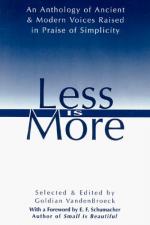|
This section contains 383 words (approx. 1 page at 400 words per page) |

|
Chapter 4 Summary and Analysis
Chapter 4
Lady Pecunia
The poem, "Lady Pecunia," by Richard Barnfield (1574-1627), is also known as "In Praise of Money." Barnfield explains that he metaphorically represents money as a lady because men love women. The poem tells of man's obsession with gold and riches and Barnfield uses a satirical tone to shine light on the issue and ridicule man's love of money.
Money as an Entity
Ruskin (1819-1900) tells of a passenger on a ship who is wearing a belt containing his gold. As the boat sinks, the man refuses to discard his belt. Ruskin asks, "Had he the gold or had the gold him?" (41). Seneca (4 B.C.-A.D. 65) notes that man does not ask the value of an item but rather what it costs. In 1961, Horace Gregory refers to money as the "invisible spirit against the human spirit" (43).
A Japanese...
(read more from the Chapter 4 Summary)
|
This section contains 383 words (approx. 1 page at 400 words per page) |

|




